Do you enjoy a smoke, inhale cannabis vapor, or consume an edible? If so, you owe an enormous debt of gratitude to the female cannabis plant. Only females provide the bud that is rich in cannabinoids such as THC that we can all enjoy. As a result, most growers look for feminized seeds that only carry female genetics. You can rely upon such seeds to produce nothing but female plants.
In contrast, non-feminized cannabis seeds produce a yield where around half of the plants are male and half are female. Male plants are useful for a breeding program. However, it is heartbreaking to have to throw away 50% of the plants at the end! Moreover, you are wasting a lot of time and space on plants you’ll ultimately have little or no use for.
This detailed guide provides information on male, female, and hermaphrodite plants. It also shows you how to feminize seeds and outlines their pros and cons. Finally, it looks at seven of the best options on the market. Let’s get started!
Hermaphrodite Plants
There is a host of misinformation relating to feminized seeds and hermaphrodites (plants that show intersexuality). While more complex organisms typically have a specific gender, marijuana doesn’t necessarily follow this pattern. Cannabis is an odd plant because it grows annually and produces male and female flowers on different plants. However, it is also capable of producing flowers of the opposite gender under specific circumstances.
As it happens, this unusual situation is a survival mechanism. It allows cannabis to reproduce while being both an annual growth plant and one that produces flowers of different sexes on different plants.
Conditions such as physical damage, light cycle, and temperature variations can cause a marijuana plant to become ‘intersexual.’
Intersexuality is a response to adverse growing conditions; in this situation, the plant is aware that it has a lower chance of reproduction. Poor growing conditions significantly reduce the plant’s chances of completing a growing season. It becomes less likely that a plant of the opposite gender will grow close enough to fertilize.
When this happens, female plants may grow male ‘staminate’ flowers to produce pollen. They can also pollinate their own female ‘pistil’ flowers and produce seeds for next year.
How Early Feminized Seeds Were Created
In the modern era, growers utilize new technologies to feminize seeds and produce a success rate of almost 100%! You won’t be surprised to learn that it was a little different at the beginning! Early attempts to feminize marijuana seeds involved the use of two female plants. One of them had hermaphroditic tendencies; it tended to produce male flowers when exposed to stress.
The hermaphrodite was deliberately stressed via pruning or exposure to a reduced light cycle. The goal was to encourage it to produce male cannabis flowers. The pollen from these flowers was applied to the other female plant. The main issue with the technique was that the pollen-donating female plants would often turn intersexual. This trait is inherited by any feminized seeds created using this method.
As you will read later on, it is a lot easier to feminize cannabis seeds these days. First, let’s take a look at the difference between male and female cannabis plants.
Male vs. Female Cannabis Plants
The trouble with naturally pollinated marijuana plants is that they tend to produce male and female seeds at around the same rate. As a result, there is only a 50% chance that you’ll yield a female plant from a regular cannabis seed. Ultimately, this means an extremely inefficient grow. You have to account for the likelihood that half your plants are male.
Unless you are a breeder, a male plant is effectively useless. Too many of them will ruin your efforts to cultivate marijuana. You can circumnavigate the problem by planting twice as many seeds as usual. After all, you know that you’ll have to cull approximately 50% of the crop. If you go down this route, you still need to identify male cannabis plants as soon as possible.
If you are a prospective grower, you already know that marijuana plants go through two life stages during their growing cycle: vegetative and flowering. You could classify the vegetative stage as a plant’s ‘childhood.’ It only focuses on becoming bigger and stronger, with no thought given to gender at this stage. You’re unlikely to have an idea of the plant’s gender for six weeks. This is around the time when plants show ‘pre-flowers.’
Therefore, you will know a plant’s gender by the beginning of the flowering stage as long as you know what to look for. At this point, your plants will begin growing buds and pollen sacs. There is a difference between the pre-flowers produced by male and female plants. Once you become an experienced grower, you can quickly tell the difference.
Male Plants
They form balls that look a little like grapes and get filled with pollen. You can spot these balls within a fortnight of the flowering stage beginning. Fail to detect the male plant in time, and the sacs will burst. Pollen will cover the surrounding area.
Female Plants
It usually takes a little longer to spot a female plant after the start of the flowering stage. They begin by showing a wispy white hair or two where their buds will ultimately start forming. You should see these hairs where the main stem connects to the nodes. You can sometimes discover this initial sign if you keep the plant in the vegetative state for a little longer.
There are many pictures online that show you the white pistils growing out of the plant’s calyxes. Just remember, female pistils are NEVER green; they are white and wispy.
Please note that there is a possibility of hermaphrodite plants, which will have both sex organs. You need to remove such plants because they will spill pollen and ruin your crop. When you find male and hermaphrodite plants, it is best to throw them out rather than looking to remove the buds by hand. You can keep a few males for breeding purposes, but otherwise, get rid of them!
Why You Should Grow from Feminized Cannabis Seeds
The most obvious reason to use feminized cannabis seeds is to take the guesswork out of growing. If you germinate regular seeds, half of them are likely male plants that you must toss away. When you feminize marijuana seeds, you can plan for a full and productive garden.
Remember, even in states where marijuana is legal to cultivate, there are limits on the number of plants you can grow. In California, for example, all adults aged 21+ can produce a maximum of six plants per household. If you use regular seeds, likely, three or even four (if you’re unlucky) of your plants will likely be males.
As well as taking up space, male plants also cost you time and resources.
You can’t tell a plant’s gender for weeks when using regular seeds. As a result, you have no choice but to cultivate them until you can determine the gender of your plants. It is normal to discover the sex of a plant by the start of the flowering stage. This is when you switch to the 12 hours of light, 12 hours of dark schedule. By that time, you have used a lot of energy and nutrients on plants that you ultimately throw away.
Feminized Cannabis Seeds Pros & Cons
Why go through so much hassle when you can feminize seeds and enjoy a near 100% success rate? However, it would be remiss of us not to mention the pros AND cons of feminized marijuana seeds. It is not an entirely ‘perfect’ solution!
Pros of Feminizing Cannabis Seeds
- Every plant will produce buds
- A near 100% strike rate means there’s no concern about wasting space on plants that you’ll eventually remove from the growing area
- There is no need to worry about watching plants at the pre-flowering stage to see if they are male or female
- Without pollen sacs from male plants, there is no chance of pollination
Cons of Feminizing Cannabis Seeds
- They are not a good choice if you aim to produce seeds because they prevent the development of male genetics.
- You need male seeds to create an active breeding program if you want to develop new and exciting strains.
- Not every seller is reputable. You could still end up with seeds derived from a low-quality feminization process, which can become hermaphrodites.
How to Feminize Cannabis Seeds
You can purchase feminized cannabis seeds from reputable breeders. However, if there are none in your area, or if you fancy a challenge, you can try to make them at home. There is an element of luck involved when attempting DIY feminization. Therefore, don’t expect a sky-high success rate. Let’s take a look at some of the most commonly used feminization techniques.
Rodelization
Although it is one of the more accessible options, it is a long way from being the most effective. It is a natural solution, but you are entirely reliant on the marijuana plant to act. The idea is to keep the female plant in the flowering state for way beyond the ideal harvest time. This causes the plant to become stressed, and it will create pollen sacs. Once the sacs appear, you can harvest the pollen.
As you can probably guess, it isn’t a very reliable method at all. Cannabis plants react differently to stress. While some strains consistently produce pollen sacs under duress, others don’t. Rodelization works best when you find a marijuana strain that reliably develops the sacs. The other problem is that you’re selecting plants that are naturally hermaphrodite. Therefore, the resulting seeds could also go that way.
Colloidal Silver
This form of silver causes a female plant to produce male pollen sacs and is far more reliable than rodelization. You can purchase colloidal silver or try to make it yourself using:
- A soldering iron
- Alligator chips
- A 9-volt battery and a connector
- Pure silver; you can use a coin or some wire, for example
- Distilled water
Finding 99.9% silver is a big challenge in this DIY process. As a result, it is best to buy a colloidal silver solution from a reputable store. Whether you purchase or create the solution, the next step is to select a female marijuana plant. Make sure you mist it daily with the silver after it flowers. Continue this process until male pollen sacs begin to form. It usually takes anywhere from 10 to 14 days for this to happen.
The pollen sacs that appear will swell and begin to open up once it is time to harvest. Keep spraying the bud sites each day until the sacs are ready. Once the sacs start to crack, collect the feminized pollen. Use it to fertilize a female plant that has been in the flowering stage for at least two weeks.
Approximately six weeks after pollination, the female plant’s calyxes will become fat and swollen. This is a sign that you should harvest the seeds once they begin coming through. Congratulations! You have created feminized seeds.
Other Methods
Cloning a female marijuana plant is a cost-efficient option with a high success rate. Technically, you are not feminizing seeds, but you do receive female plants and buds. Although cloning is very useful, it only allows you to create a single strain time and again. That’s great news if you love the strain, but it doesn’t allow for experimentation.
If you opt to buy feminized seeds, it helps you to explore what is an ever-growing field of cannabis strains.
The Best Feminized Cannabis Seeds on the Market
If you’re planning to grow cannabis and want to buy feminized cannabis seeds, here are seven of the best strains.
1 – Northern Lights
- Growing Difficulty: Easy
- Ready for Harvest: 7-9 weeks, or mid-October
- Where to Buy: Royal Queen Seeds
Northern Lights is a household name. Among cannabis enthusiasts, it is a famed strain that almost everyone knows. It possesses 90% indica genetics with the effects to match, producing a stoned body high that will leave a smile plastered to your face.
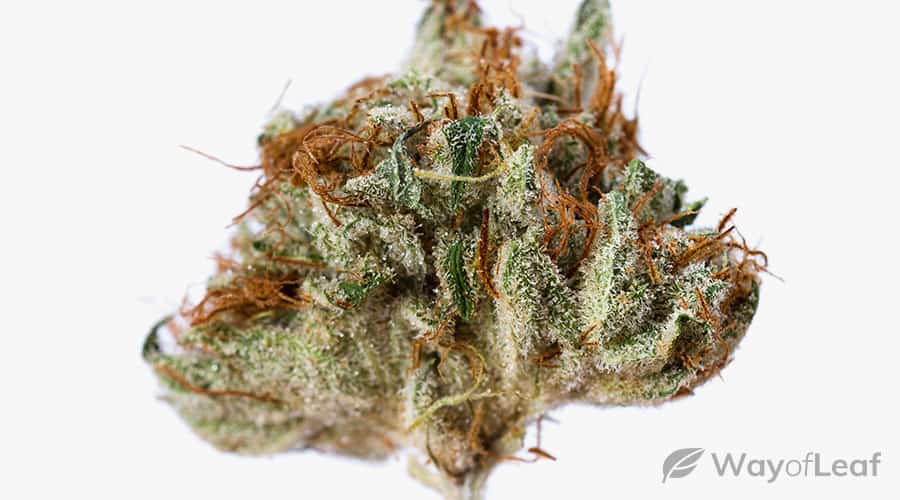
As for growing Northern Lights, you’re best off in a warm, Mediterranean climate. Those in California will have luck with this strain. As for indoor growing, you will need to keep the temperature warm and relatively humid.
Apart from temperature regulation, Northern Lights is a pretty easy grower. You can use either a soil medium or a hydroponics set-up, and the crop will reward you with 18 ounces per square meter. Meanwhile, outdoor crops can provide 22 ounces per plant!
As a feminized strain, you’ll have no problem growing Northern Lights.
2 – Amnesia Haze
- Growing Difficulty: Moderate
- Ready for Harvest: 9 weeks, or late October
- Where to Buy: Soma Seeds
Amnesia Haze is another famed strain, this time a delightful sativa. It hails from Holland, a land known for high-quality buds. As a top-shelf sativa, you can expect pleasant effects during the high, including euphoria, laughter, and energy. With a 21% THC content, you need to be careful with this one.
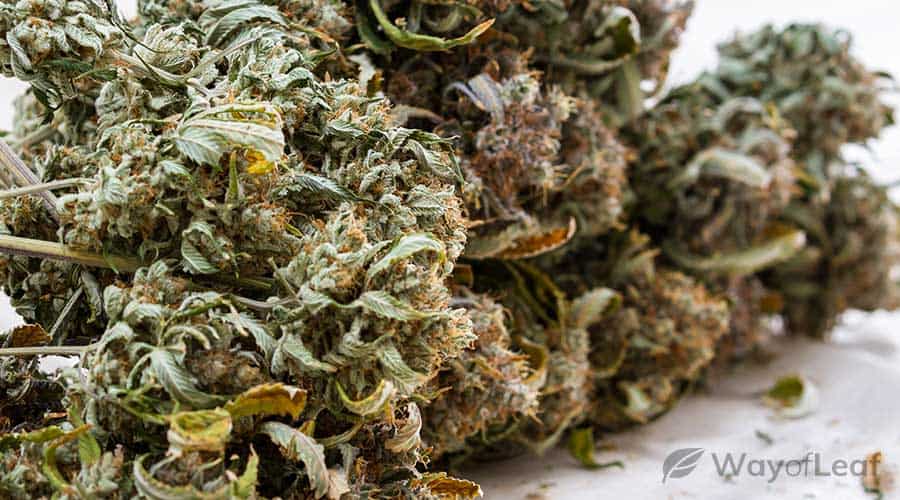
It’s a moderately tricky strain to grow. While not the easiest around, it’s still an ideal strain for intermediate growers looking to progress onto something slightly trickier. Amnesia Haze prefers a balmy Mediterranean climate; however, it’s best to grow it indoors.
This strain is susceptible to pests, and it’s better to attempt temperature control by keeping it inside. You should always use compost to help protect it from molds and infections. The indoor yield is about 21 ounces per meter squared, a very reasonable amount of bud. Plus, with feminized seeds, you don’t have to worry about a corrupt crop.
3 – White Widow
- Growing Difficulty: Easy
- Ready for Harvest: 8-10 weeks, or late October
- Where to Buy: Royal Queen Seeds
White Widow is named for the smattering of white trichomes covering the plant, giving it a shimmering appearance. These trichomes produce a potent plant, with an average THC content of around 22.5%. As a result, this strain is not for those new to cannabis. It’s also a 60/40 hybrid with indica leanings.
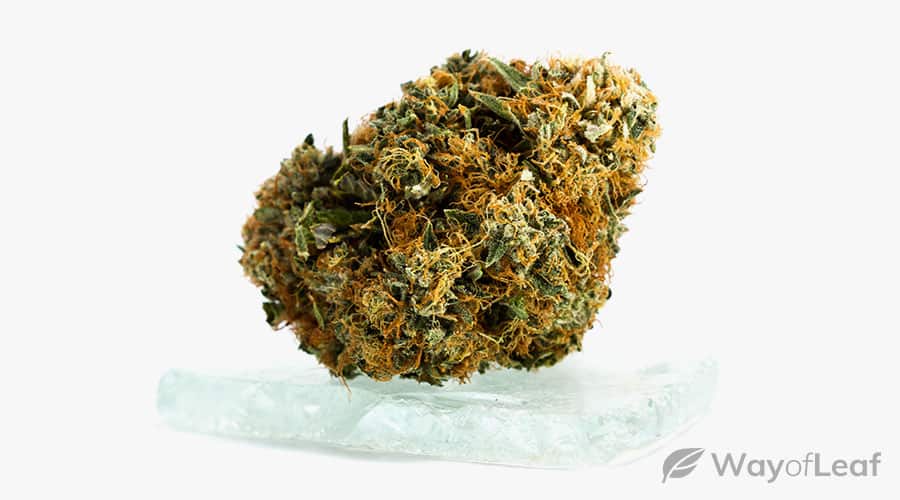
The high from White Widow is euphoric, but with a decent burst of energy and sociality, it’s a great strain to enjoy when chilling with friends.
For growers, White Widow is a blessing. It’s resistant to molds, pests, and colder temperatures. You can cultivate it pretty much anywhere, and it grows well without much intervention.
Although it flowers indoors in 8 weeks, you can push it up to 10 weeks to encourage greater trichome production and more potent bud. The trichomes also carry some of the skunky flavors.
Royal Queen Seeds now stocks a feminized version of the classic White Widow strain. It even recommends this strain specifically to new growers; take their word for it!
4 – Bubba Kush
- Growing Difficulty: Easy-Moderate
- Ready for Harvest: 8-10 weeks, or mid-October
- Where to Buy: Humboldt Seeds
Bubba Kush is a strain with a long history, named after a legendary grower called Bubba. It was probably bred sometime during the 90s. Nowadays, it is still enjoyed for its hybrid effects. Bubba Kush makes the user feel happy but sedated, rested, but delighted. This is not a strain to miss with its 19% THC content and coffee, chocolate flavors.
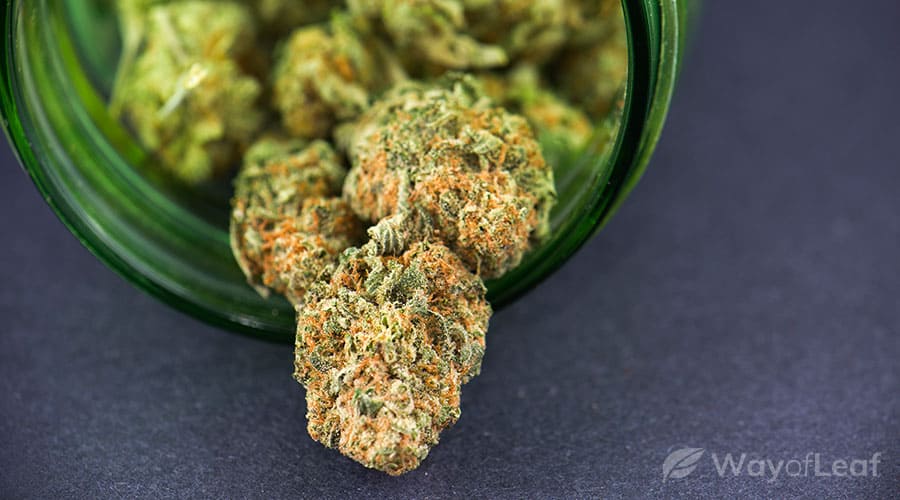
For cultivators, Bubba Kush is reasonably easy to grow. It is naturally quite resistant to molds and pests and can be grown both indoors and outdoors. It is quite well suited for indoor growing with a relatively short height of 2-4 feet.
Using the Sea of Green (SoG) technique, growers can expect a decent yield. Outdoors, Bubba Kush can produce 21-28 ounces per plant, while indoor plants may produce 18 ounces per meter squared.
Feminized Bubba Kush seeds are now widely available online. Thanks to its easy growing, these feminized seeds are ideal for new growers.
5 – Green Crack
- Growing Difficulty: Easy
- Ready for Harvest: 7-9 weeks, or late September
- Where to Buy: Humboldt Seeds
Supposedly named by Snoop Dogg himself, Green Crack is another famous strain. It’s a sativa-dominant cannabis variety packing a ton of incredible effects. With delicious flavors like mango and citrus, and an array of spacey, cerebral effects, it’s no wonder Green Crack remains popular.
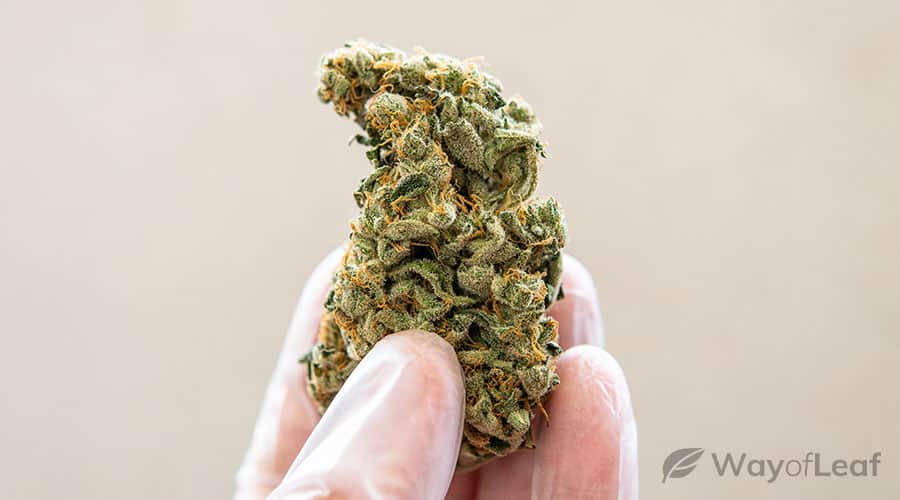
Green Crack is widely renowned as an excellent strain for new growers. Outdoors, Green Crack enjoys a sunny Mediterranean climate with decent humidity. However, it can’t be too humid because Green Crack is sensitive to mildew.
Fortunately, Green Crack can thrive in a range of growing mediums, including hydroponics set-ups. The plants will reach around 3-4 feet tall, which is on the small side for a sativa. Indoor plants will yield about 18 ounces per square meter – reasonable for a short flowering period. Outdoor grows can reward you with 20 ounces per plant.
We probably have Green Crack’s hip-hop fame to thank for the prevalence of feminized seeds, so you shouldn’t have trouble finding them online.
6 – Blue Cheese
- Growing Difficulty: Easy
- Ready for Harvest: 8-9 weeks, or early October
- Where to Buy: Barney’s Farm
You may guess from the name, but Blue Cheese possesses a potent, cheesy aroma and flavor. Luckily, there are sweet notes of blueberry and spicy tones in there to balance it out. Cheese-lovers adore the Blue Cheese strain for its taste and effects. This indica-dominant hybrid offers euphoria and relaxation rolled into one strain.
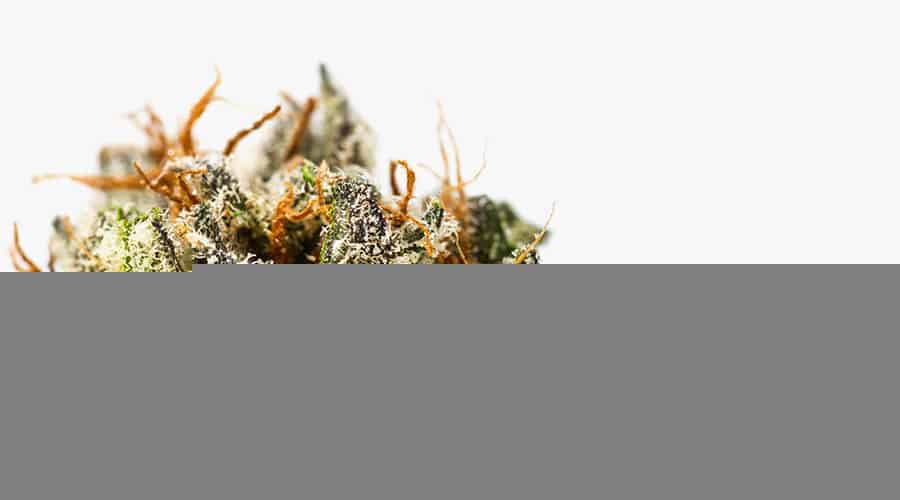
As far as growing is concerned, Blue Cheese is surprisingly easy to cultivate. It’s naturally resistant to mold, powdery mildew, and various insects. It can also survive in colder environments compared to other strains. As a result, you don’t need to be a botany expert to help this strain thrive.
The flowering period is relatively short, at 8-9 weeks. Outdoors, it’s ready by the end of September or early October. The yield is decent, too, with 19 ounces per square meter indoors and 19 ounces per plant outside.
Enjoy the delightful effects of Blue Cheese by growing it yourself!
7 – Purple Queen
- Growing Difficulty: Moderate
- Ready for Harvest: 8-9 weeks, or October
- Where to Buy: Royal Queen Seeds
The best part about growing Purple Queen is the rewarding results of purple-colored cannabis. The indica effects are also something to behold, with a fantastic body high. Vibrant purple coloring and delectable pine aromas are all things to look forward to from Purple Queen.

Plus, this strain is feminized and fairly easy to grow. It thrives in temperate climates, but you will likely need to reduce the temperature toward the flowering stage to encourage purple buds.
By the way, Purple Queen is relatively resistant to mold, so you can sit back and enjoy what this strain has to offer. The only complicated part is bringing out the coloration.
Indoors, Purple Queen provides just short of 18 ounces per square meter and 24 ounces per plant outside.
What Are Feminized Seeds? Final Thoughts
Growing cannabis in the home is legal in several American states. However, please check your state’s laws for more information. Even in these locations, you can only grow a relatively small number of plants in your home. Therefore, don’t waste your allocation and garden space by risking regular seeds.
As a home grower, you can create feminized cannabis seeds by using colloidal silver. All it takes is a little patience, and you could end up with a garden filled with female plants.
If you don’t use feminized strains in your garden, you effectively grow a crop half-filled with plants you won’t use.
Don’t have the time, resources, know-how, or money to create feminized seeds? In that case, you can easily purchase them from a reputable supplier.
If you don’t use feminized strains in your garden, you effectively grow a crop half-filled with plants you won’t use. That is a severe waste of time, energy, and space.


![8 Tips for Growing Skywalker OG Marijuana [Grower’s Guide]](https://wayofleaf.com/wp-content/uploads/2019/01/wol_growing-skywalker-og-marijuana-640x225.jpg)


![8 Tips for Growing God Bud Cannabis [Grower’s Guide]](https://wayofleaf.com/wp-content/uploads/2018/11/wol-banner-8-tips-for-growing-god-bud-cannabis-640x225.jpg)
![Growing White Widow Cannabis [The Grower’s Guide]](https://wayofleaf.com/wp-content/uploads/2018/09/wol_1920x450-13-640x225.jpg)
![Who Grows the Best Weed in California? [We Reveal the Truth]](https://wayofleaf.com/wp-content/uploads/2018/07/mj_who-grows-the-best-weed-in-california-answered-640x225.jpg)


![How to Solve Drooping Weed [Essential Hacks]](https://wayofleaf.com/wp-content/uploads/2019/08/wol-banner-drooping-weed-640x225.jpg)

